Innova 2020: A Follow-Up Study of the Fecal Microbiota of Infants Using a Novel Infant Formula between 6 Months and 12 Months of Age
Abstract
1. Introduction
2. Results
2.1. Phyla and Genera Distribution
2.2. Rivera-Pinto Method Analysis
2.3. Calprotectin, IgA, and SCFAs
2.4. Metabolic Pathways
2.5. Correlations between Bacterial Diversity Indices, Bacterial Variables, SCFA Levels, Metabolic Traits, and Clinical Outcomes
3. Discussion
Limitations and Strengths
4. Materials and Methods
4.1. Ethical Considerations
4.2. Design of the Trial
4.3. Characteristics of the Formula
- o
- Group 1: Nutribén® Innova 1 (INN; infant formula 1)
- o
- Group 2: Nutribén® Standard (STD; infant formula 2)
- o
- Group 3: BF (Exploratory analysis with external controls)
4.4. Sampling Process
4.5. Extraction of DNA
4.6. Analysis of Sequences and Bioinformatics
4.7. Functional Profiles
4.8. Biochemical Analysis
4.9. Rivera-Pinto Analysis
4.10. Statistical Analysis
5. Conclusions
Supplementary Materials
Author Contributions
Funding
Institutional Review Board Statement
Informed Consent Statement
Data Availability Statement
Acknowledgments
Conflicts of Interest
References
- World Health Organization. The Optimal Duration of Exclusive Breastfeeding: A Systematic Review. Available online: https://apps.who.int/iris/bitstream/handle/10665/67208/WHO_NHD_01.08.pdf (accessed on 6 December 2022).
- Black, R.E.; Victora, C.G.; Walker, S.P.; Bhutta, Z.A.; Christian, P.; De Onis, M.; Ezzati, M.; Grantham-McGregor, S.; Katz, J.; Martorell, R. Maternal and child undernutrition and overweight in low-income and middle-income countries. Lancet 2013, 382, 427–451. [Google Scholar] [CrossRef]
- Ogbu, C.E.; Fongue, S.; Ogbu, S.C.; Kirby, R.S. Infant feeding practices and asthma in children aged 6 months to 5 years using a propensity score approach. Cent. Eur. J. Public Health 2021, 29, 284–289. [Google Scholar] [CrossRef]
- Rameez, R.M.; Sadana, D.; Kaur, S.; Ahmed, T.; Patel, J.; Khan, M.S.; Misbah, S.; Simonson, M.T.; Riaz, H.; Ahmed, H.M. Association of Maternal Lactation With Diabetes and Hypertension: A Systematic Review and Meta-analysis. JAMA Netw. Open 2019, 2, e1913401. [Google Scholar] [CrossRef] [PubMed]
- Victora, C.G.; Bahl, R.; Barros, A.J.; França, G.V.; Horton, S.; Krasevec, J.; Murch, S.; Sankar, M.J.; Walker, N.; Rollins, N.C. Breastfeeding in the 21st century: Epidemiology, mechanisms, and lifelong effect. Lancet 2016, 387, 475–490. [Google Scholar] [CrossRef] [PubMed]
- Christian, P.; Smith, E.R.; Lee, S.E.; Vargas, A.J.; Bremer, A.A.; Raiten, D.J. The need to study human milk as a biological system. Am. J. Clin. Nutr. 2021, 113, 1063–1072. [Google Scholar] [CrossRef] [PubMed]
- World Health Organization. World Health Organization, Breastfeeding Recommendations. Available online: https://www.who.int/health-topics/breastfeeding/ (accessed on 6 December 2022).
- Bäckhed, F.; Roswall, J.; Peng, Y.; Feng, Q.; Jia, H.; Kovatcheva-Datchary, P.; Li, Y.; Xia, Y.; Xie, H.; Zhong, H.; et al. Dynamics and Stabilization of the Human Gut Microbiome during the First Year of Life. Cell Host Microbe 2015, 17, 690–703. [Google Scholar] [CrossRef]
- Guittar, J.; Shade, A.; Litchman, E. Trait-based community assembly and succession of the infant gut microbiome. Nat. Commun. 2019, 10, 512. [Google Scholar] [CrossRef]
- Carver, J.D. Advances in nutritional modifications of infant formulas. Am. J. Clin. Nutr. 2003, 77, 1550S–1554S. [Google Scholar] [CrossRef]
- Koletzko, B.; Baker, S.; Cleghorn, G.; Neto, U.F.; Gopalan, S.; Hernell, O.; Hock, Q.S.; Jirapinyo, P.; Lonnerdal, B.; Pencharz, P.; et al. Global standard for the composition of infant formula: Recommendations of an ESPGHAN coordinated international expert group. J. Pediatr. Gastroenterol. Nutr. 2005, 41, 584–599. [Google Scholar] [CrossRef]
- Commission Delegated Regulation. Commission Delegated Regulation (EU) 2016/127 of 25 September 2015 Supplementing Regulation (EU) No 609/2013 of the European Parliament and of the Council as Regards the Specific Compositional and Information Requirements for Infant Formula and Follow-on Formula and as Regards Requirements on Information Relating to Infant and Young Child Feeding. Available online: https://eur-lex.europa.eu/legal-content/EN/TXT/?uri=celex%3A32016R0127 (accessed on 9 April 2023).
- World Health Organization, (WHO). CODEX alimentarius: Standard for infant formula and formulas for special medical purposes intended for infants. In Revised Standard for Infant Formula; Food and Agriculture Organization of the United Nations: Rome, Italy, 1981. [Google Scholar]
- Food and Drug Administration. Infant Formula Requirements Pertaining to Current Good Manufacturing Practice, Quality Control Procedures, Quality Factors, Records and Reports and Notifications. Code Fed. Regul. 2019, 2, 106. Available online: https://www.accessdata.fda.gov/scripts/cdrh/cfdocs/cfcfr/CFRSearch.cfm?CFRPart=106&showFR=1 (accessed on 9 April 2023).
- Koletzko, B.; Bergmann, K.; Brenna, J.T.; Calder, P.C.; Campoy, C.; Clandinin, M.T.; Colombo, J.; Daly, M.; Decsi, T.; Demmelmair, H. Should formula for infants provide arachidonic acid along with DHA? A position paper of the European Academy of Paediatrics and the Child Health Foundation. Am. J. Clin. Nutr. 2020, 111, 10–16. [Google Scholar] [CrossRef]
- Davis, A.M.; Harris, B.J.; Lien, E.L.; Pramuk, K.; Trabulsi, J. Alpha-lactalbumin-rich infant formula fed to healthy term infants in a multicenter study: Plasma essential amino acids and gastrointestinal tolerance. Eur. J. Clin. Nutr. 2008, 62, 1294–1301. [Google Scholar] [CrossRef]
- Campoy, C.; Chisaguano Tonato, A.M.; de la Garza Puentes, A.; Sáenz de Pipaón, M.; Verduci, E.; Koletzko, B.; Casanova, G.; Larqué, E.; Valenzuela, R.; Moreno Villares, J.M.; et al. Controversy about the critical role of long-chain polyunsaturated fatty acids, arachidonic acid (ARA) and docosahexaenoic acid (DHA), during infancy. Nutr. Hosp. 2021, 38, 1101–1112. [Google Scholar]
- Balaguer, F.; Enrique, M.; Llopis, S.; Barrena, M.; Navarro, V.; Álvarez, B.; Chenoll, E.; Ramón, D.; Tortajada, M.; Martorell, P. Lipoteichoic acid from Bifidobacterium animalis subsp. lactis BPL1: A novel postbiotic that reduces fat deposition via IGF-1 pathway. Microb. Biotechnol. 2022, 15, 805–816. [Google Scholar] [CrossRef] [PubMed]
- Carreras, N.L.; Martorell, P.; Chenoll, E.; Genovés, S.; Ramón, D.; Aleixandre, A. Anti-obesity properties of the strain Bifidobacterium animalis subsp. lactis CECT 8145 in Zücker fatty rats. Benef. Microbes 2018, 9, 629–641. [Google Scholar] [CrossRef]
- Pedret, A.; Valls, R.M.; Calderón-Pérez, L.; Llauradó, E.; Companys, J.; Pla-Pagà, L.; Moragas, A.; Martín-Luján, F.; Ortega, Y.; Giralt, M. Effects of daily consumption of the probiotic Bifidobacterium animalis subsp. lactis CECT 8145 on anthropometric adiposity biomarkers in abdominally obese subjects: A randomized controlled trial. Int. J. Obes. 2019, 43, 1863–1868. [Google Scholar] [CrossRef] [PubMed]
- Silva, Á.; Gonzalez, N.; Terrén, A.; García, A.; Martinez-Blanch, J.F.; Illescas, V.; Morales, J.; Maroto, M.; Genovés, S.; Ramón, D. An infant milk formula supplemented with heat-treated probiotic Bifidobacterium animalis subsp. lactis CECT 8145, reduces fat deposition in C. elegans and augments acetate and lactate in a fermented infant slurry. Foods 2020, 9, 652. [Google Scholar] [CrossRef]
- Nermes, M.; Kantele, J.; Atosuo, T.; Salminen, S.; Isolauri, E. Interaction of orally administered Lactobacillus rhamnosus GG with skin and gut microbiota and humoral immunity in infants with atopic dermatitis. Clin. Exp. Allergy 2011, 41, 370–377. [Google Scholar] [CrossRef] [PubMed]
- Wall, R.; Ross, R.; Ryan, C.; Hussey, S.; Murphy, B.; Fitzgerald, G.; Stanton, C. Role of gut microbiota in early infant development. Clin. Med. Pediatr. 2009, 3, 45–54. [Google Scholar] [CrossRef]
- Plaza-Diaz, J.; Ruiz-Ojeda, F.J.; Morales, J.; de la Torre, A.I.; García-García, A.; de Prado, C.N.; Coronel-Rodríguez, C.; Crespo, C.; Ortega, E.; Martín-Pérez, E.; et al. Effects of a Novel Infant Formula on Weight Gain, Body Composition, Safety and Tolerability to Infants: The INNOVA 2020 Study. Nutrients 2023, 15, 147. [Google Scholar] [CrossRef]
- Ruiz-Ojeda, F.J.; Plaza-Díaz, J.; Morales, J.; Cristina de la Torre, A.I.; García-García, A.; de Prado, C.N.; Coronel, C.; Crespo, C.; Ortega, E.; Martín-Pérez, E.; et al. A multicenter, randomized, blinded, controlled clinical trial investigating the effect of a novel infant formula on the body composition of infants: INNOVA 2020 study protocol. Adv. Pediatr. Res. 2022, 9, 041. [Google Scholar]
- Ruiz-Ojeda, F.J.P.-D.J.; Morales, J.; Álvarez-Calatayud, G.; Climent, E.; Silva, Á.; Martinez-Blanch, J.F.; Enrique, M.; Tortajada, M.; Ramon, D.; Alvarez, B.; et al. Effects of a Novel Infant Formula on the Fecal Microbiota in the First Six Months of Life: The INNOVA 2020 Study. Int. J. Mol. Sci. 2023, 24, 3034. [Google Scholar] [CrossRef] [PubMed]
- Plaza-Diaz, J.; Manzano, M.; Ruiz-Ojeda, F.J.; Giron, M.D.; Salto, R.; Lopez-Pedrosa, J.M.; Santos-Fandila, A.; Garcia-Corcoles, M.T.; Rueda, R.; Gil, A. Intake of slow-digesting carbohydrates is related to changes in the microbiome and its functional pathways in growing rats with obesity induced by diet. Front. Nutr. 2022, 9, 992682. [Google Scholar] [CrossRef] [PubMed]
- Rivera-Pinto, J.; Egozcue, J.J.; Pawlowsky-Glahn, V.; Paredes, R.; Noguera-Julian, M.; Calle, M.L. Balances: A New Perspective for Microbiome Analysis. mSystems 2018, 3, e00053-00018. [Google Scholar] [CrossRef] [PubMed]
- Martin-Rodriguez, A.; Bustamante-Sanchez, A.; Martinez-Guardado, I.; Navarro-Jimenez, E.; Plata-SanJuan, E.; Tornero-Aguilera, J.F.; Clemente-Suarez, V.J. Infancy Dietary Patterns, Development, and Health: An Extensive Narrative Review. Children 2022, 9, 1072. [Google Scholar] [CrossRef]
- Cena, H.; Calder, P.C. Defining a Healthy Diet: Evidence for The Role of Contemporary Dietary Patterns in Health and Disease. Nutrients 2020, 12, 334. [Google Scholar] [CrossRef]
- European Food Safety Authority. Scientific opinion on the appropriate age for introduction of complementary feeding of infants. EFSA J. 2009, 7, 1423. [Google Scholar] [CrossRef]
- World Health Organization. Infant and Young Child Feeding: Model Chapter for Textbooks for Medical Students and Allied Health Professionals; World Health Organization: Geneva, Switzerland, 2009. [Google Scholar]
- Azad, M.B.; Konya, T.; Maughan, H.; Guttman, D.S.; Field, C.J.; Chari, R.S.; Sears, M.R.; Becker, A.B.; Scott, J.A.; Kozyrskyj, A.L. Gut microbiota of healthy Canadian infants: Profiles by mode of delivery and infant diet at 4 months. CMAJ 2013, 185, 385–394. [Google Scholar] [CrossRef]
- Song, S.J.; Dominguez-Bello, M.G.; Knight, R. How delivery mode and feeding can shape the bacterial community in the infant gut. CMAJ 2013, 185, 373–374. [Google Scholar] [CrossRef]
- Saturio, S.; Nogacka, A.M.; Suarez, M.; Fernandez, N.; Mantecon, L.; Mancabelli, L.; Milani, C.; Ventura, M.; de Los Reyes-Gavilan, C.G.; Solis, G.; et al. Early-Life Development of the Bifidobacterial Community in the Infant Gut. Int. J. Mol. Sci. 2021, 22, 3382. [Google Scholar] [CrossRef]
- Hascoet, J.M.; Hubert, C.; Rochat, F.; Legagneur, H.; Gaga, S.; Emady-Azar, S.; Steenhout, P.G. Effect of formula composition on the development of infant gut microbiota. J. Pediatr. Gastroenterol. Nutr. 2011, 52, 756–762. [Google Scholar] [CrossRef] [PubMed]
- Mancabelli, L.; Tarracchini, C.; Milani, C.; Lugli, G.A.; Fontana, F.; Turroni, F.; van Sinderen, D.; Ventura, M. Multi-population cohort meta-analysis of human intestinal microbiota in early life reveals the existence of infant community state types (ICSTs). Comput. Struct. Biotechnol. J. 2020, 18, 2480–2493. [Google Scholar] [CrossRef]
- Tannock, G.W.; Lawley, B.; Munro, K.; Gowri Pathmanathan, S.; Zhou, S.J.; Makrides, M.; Gibson, R.A.; Sullivan, T.; Prosser, C.G.; Lowry, D.; et al. Comparison of the compositions of the stool microbiotas of infants fed goat milk formula, cow milk-based formula, or breast milk. Appl. Environ. Microbiol. 2013, 79, 3040–3048. [Google Scholar] [CrossRef] [PubMed]
- Fallani, M.; Amarri, S.; Uusijarvi, A.; Adam, R.; Khanna, S.; Aguilera, M.; Gil, A.; Vieites, J.M.; Norin, E.; Young, D. Determinants of the human infant intestinal microbiota after the introduction of first complementary foods in infant samples from five European centres. Microbiology 2011, 157, 1385–1392. [Google Scholar] [CrossRef]
- Kato, K.; Odamaki, T.; Mitsuyama, E.; Sugahara, H.; Xiao, J.Z.; Osawa, R. Age-Related Changes in the Composition of Gut Bifidobacterium Species. Curr. Microbiol. 2017, 74, 987–995. [Google Scholar] [CrossRef] [PubMed]
- Lin, C.; Lin, Y.; Zhang, H.; Wang, G.; Zhao, J.; Zhang, H.; Chen, W. Intestinal ‘Infant-Type’ Bifidobacteria Mediate Immune System Development in the First 1000 Days of Life. Nutrients 2022, 14, 1498. [Google Scholar] [CrossRef]
- Arboleya, S.; Watkins, C.; Stanton, C.; Ross, R.P. Gut Bifidobacteria Populations in Human Health and Aging. Front. Microbiol. 2016, 7, 1204. [Google Scholar] [CrossRef]
- Koenig, J.E.; Spor, A.; Scalfone, N.; Fricker, A.D.; Stombaugh, J.; Knight, R.; Angenent, L.T.; Ley, R.E. Succession of microbial consortia in the developing infant gut microbiome. Proc. Natl. Acad. Sci. USA 2011, 108, 4578–4585. [Google Scholar] [CrossRef]
- Michelini, S.; Balakrishnan, B.; Parolo, S.; Matone, A.; Mullaney, J.A.; Young, W.; Gasser, O.; Wall, C.; Priami, C.; Lombardo, R.; et al. A reverse metabolic approach to weaning: In silico identification of immune-beneficial infant gut bacteria, mining their metabolism for prebiotic feeds and sourcing these feeds in the natural product space. Microbiome 2018, 6, 171. [Google Scholar] [CrossRef]
- Gomez-Llorente, C.; Plaza-Diaz, J.; Aguilera, M.; Munoz-Quezada, S.; Bermudez-Brito, M.; Peso-Echarri, P.; Martinez-Silla, R.; Vasallo-Morillas, M.I.; Campana-Martin, L.; Vives-Pinera, I.; et al. Three main factors define changes in fecal microbiota associated with feeding modality in infants. J. Pediatr. Gastroenterol. Nutr. 2013, 57, 461–466. [Google Scholar] [CrossRef]
- Harmsen, H.J.; Wildeboer–Veloo, A.C.; Raangs, G.C.; Wagendorp, A.A.; Klijn, N.; Bindels, J.G.; Welling, G.W. Analysis of intestinal flora development in breast-fed and formula-fed infants by using molecular identification and detection methods. J. Pediatr. Gastroenterol. Nutr. 2000, 30, 61–67. [Google Scholar] [CrossRef] [PubMed]
- Hyeon, J.-Y.; Park, C.; Choi, I.-S.; Holt, P.S.; Seo, K.-H. Development of multiplex real-time PCR with Internal amplification control for simultaneous detection of Salmonella and Cronobacter in powdered infant formula. Int. J. Food Microbiol. 2010, 144, 177–181. [Google Scholar] [CrossRef] [PubMed]
- Matharu, D.; Ponsero, A.J.; Dikareva, E.; Korpela, K.; Kolho, K.L.; de Vos, W.M.; Salonen, A. Bacteroides abundance drives birth mode dependent infant gut microbiota developmental trajectories. Front. Microbiol. 2022, 13, 953475. [Google Scholar] [CrossRef]
- Pham, V.T.; Greppi, A.; Chassard, C.; Braegger, C.; Lacroix, C. Stepwise establishment of functional microbial groups in the infant gut between 6 months and 2 years: A prospective cohort study. Front. Nutr. 2022, 9, 948131. [Google Scholar] [CrossRef] [PubMed]
- Lindenberg, F.; Krych, L.; Fielden, J.; Kot, W.; Frokiaer, H.; van Galen, G.; Nielsen, D.S.; Hansen, A.K. Expression of immune regulatory genes correlate with the abundance of specific Clostridiales and Verrucomicrobia species in the equine ileum and cecum. Sci. Rep. 2019, 9, 12674. [Google Scholar] [CrossRef]
- Penders, J.; Thijs, C.; Vink, C.; Stelma, F.F.; Snijders, B.; Kummeling, I.; van den Brandt, P.A.; Stobberingh, E.E. Factors influencing the composition of the intestinal microbiota in early infancy. Pediatrics 2006, 118, 511–521. [Google Scholar] [CrossRef]
- Pathirana, W.G.W.; Chubb, S.P.; Gillett, M.J.; Vasikaran, S.D. Faecal Calprotectin. Clin. Biochem. Rev. 2018, 39, 77–90. [Google Scholar]
- Breedveld, A.; Van Egmond, M. IgA and FcαRI: Pathological roles and therapeutic opportunities. Front. Immunol. 2019, 10, 553. [Google Scholar] [CrossRef]
- Mkaddem, S.B.; Christou, I.; Rossato, E.; Berthelot, L.; Lehuen, A.; Monteiro, R.C. IgA, IgA receptors, and their anti-inflammatory properties. In Fc Receptors; Springer: Cham, Switzerland, 2014; pp. 221–235. [Google Scholar]
- Puigserver, P. Signaling transduction and metabolomics. In Hematology; Elsevier: Amsterdam, The Netherlands, 2018; pp. 68–78. [Google Scholar]
- Gupta, K.P.; Singh, J. Modulation of carcinogen metabolism and DNA interaction by calcium glucarate in mouse skin. Toxicol. Sci. 2004, 79, 47–55. [Google Scholar] [CrossRef]
- Yang, W.; Zhou, G.; Zou, S.; Yang, W.; Liu, A.; Sun, S.; Xie, B. Metabonomics of D-glucaro-1,4-lactone in preventing diethylnitrosamine-induced liver cancer in rats. Pharm. Biol. 2018, 56, 643–648. [Google Scholar] [CrossRef]
- Maeda, S.; Shimizu, K.; Kihira, C.; Iwabu, Y.; Kato, R.; Sugimoto, M.; Fukiya, S.; Wada, M.; Yokota, A. Pyruvate dehydrogenase complex regulator (PdhR) gene deletion boosts glucose metabolism in Escherichia coli under oxygen-limited culture conditions. J. Biosci. Bioeng. 2017, 123, 437–443. [Google Scholar] [CrossRef]
- Moxley, W.C.; Eiteman, M.A. Pyruvate Production by Escherichia coli by Use of Pyruvate Dehydrogenase Variants. Appl. Environ. Microbiol. 2021, 87, e0048721. [Google Scholar] [CrossRef] [PubMed]
- Emiola, A.; George, J.; Andrews, S.S. A Complete Pathway Model for Lipid A Biosynthesis in Escherichia coli. PLoS ONE 2014, 10, e0121216. [Google Scholar] [CrossRef]
- Parthasarathy, A.; Cross, P.J.; Dobson, R.C.J.; Adams, L.E.; Savka, M.A.; Hudson, A.O. A Three-Ring Circus: Metabolism of the Three Proteogenic Aromatic Amino Acids and Their Role in the Health of Plants and Animals. Front. Mol. Biosci. 2018, 5, 29. [Google Scholar] [CrossRef] [PubMed]
- Bolte, L.A.; Vich Vila, A.; Imhann, F.; Collij, V.; Gacesa, R.; Peters, V.; Wijmenga, C.; Kurilshikov, A.; Campmans-Kuijpers, M.J.E.; Fu, J.; et al. Long-term dietary patterns are associated with pro-inflammatory and anti-inflammatory features of the gut microbiome. Gut 2021, 70, 1287–1298. [Google Scholar] [CrossRef]
- AAP, F.L.; Bell, E.; Cooke, R.; Fomon, S.; Kleinman, R.; Pencharz, P.; Reynolds, J.; Schanler, R.; Forbes, A. Task Force on Clinical Testing of Infant Formulas, Committee on Nutrition, American Academy of Pediatrics: Clinical testing of infant formulas with respect to nutritional suitability for term infants. In Center for Food Safety and Applied Nutrition; US Food and Drug Administration: Silver Spring, MD, USA, 1988; pp. 1–16. [Google Scholar]
- EFSA Panel on Food Additives and Nutrient Sources added to Food (ANS); Younes, M.; Aggett, P.; Aguilar, F.; Crebelli, R.; Dusemund, B.; Filipič, M.; Frutos, M.J.; Galtier, P.; Gundert-Remy, U.; et al. Scientific opinion on the evaluation of authorised ferric sodium EDTA as an ingredient in the context of Regulation (EC) 258/97 on novel foods and Regulation (EU) 609/2013 on food intended for infants and young children, food for special medical purposes and total diet replacement for weight control. EFSA J. 2018, 16, e05369. [Google Scholar]
- Yuan, S.; Cohen, D.B.; Ravel, J.; Abdo, Z.; Forney, L.J. Evaluation of methods for the extraction and purification of DNA from the human microbiome. PLoS ONE 2012, 7, e33865. [Google Scholar] [CrossRef] [PubMed]
- Klindworth, A.; Pruesse, E.; Schweer, T.; Peplies, J.; Quast, C.; Horn, M.; Glöckner, F.O. Evaluation of general 16S ribosomal RNA gene PCR primers for classical and next-generation sequencing-based diversity studies. Nucleic Acids Res. 2013, 41, e1. [Google Scholar] [CrossRef] [PubMed]
- Bolyen, E.; Rideout, J.R.; Dillon, M.R.; Bokulich, N.A.; Abnet, C.C.; Al-Ghalith, G.A.; Alexander, H.; Alm, E.J.; Arumugam, M.; Asnicar, F. Reproducible, interactive, scalable and extensible microbiome data science using QIIME 2. Nat. Biotechnol. 2019, 37, 852–857. [Google Scholar] [CrossRef]
- Callahan, B.J.; McMurdie, P.J.; Rosen, M.J.; Han, A.W.; Johnson, A.J.A.; Holmes, S.P. DADA2: High-resolution sample inference from Illumina amplicon data. Nat. Methods 2016, 13, 581–583. [Google Scholar] [CrossRef]
- Katoh, K.; Standley, D.M. MAFFT multiple sequence alignment software version 7: Improvements in performance and usability. Mol. Biol. Evol. 2013, 30, 772–780. [Google Scholar] [CrossRef] [PubMed]
- Price, M.N.; Dehal, P.S.; Arkin, A.P. FastTree 2–approximately maximum-likelihood trees for large alignments. PLoS ONE 2010, 5, e9490. [Google Scholar] [CrossRef] [PubMed]
- Bokulich, N.A.; Kaehler, B.D.; Rideout, J.R.; Dillon, M.; Bolyen, E.; Knight, R.; Huttley, G.A.; Gregory Caporaso, J. Optimizing taxonomic classification of marker-gene amplicon sequences with QIIME 2′s q2-feature-classifier plugin. Microbiome 2018, 6, 90. [Google Scholar] [CrossRef]
- Quast, C.; Pruesse, E.; Yilmaz, P.; Gerken, J.; Schweer, T.; Yarza, P.; Peplies, J.; Glöckner, F.O. The SILVA ribosomal RNA gene database project: Improved data processing and web-based tools. Nucleic Acids Res. 2012, 41, D590–D596. [Google Scholar] [CrossRef] [PubMed]
- Dixon, P. VEGAN, a package of R functions for community ecology. J. Veg. Sci. 2003, 14, 927–930. [Google Scholar] [CrossRef]
- Douglas, G.M.; Maffei, V.J.; Zaneveld, J.R.; Yurgel, S.N.; Brown, J.R.; Taylor, C.M.; Huttenhower, C.; Langille, M.G.I. PICRUSt2 for prediction of metagenome functions. Nat. Biotechnol. 2020, 38, 685–688. [Google Scholar] [CrossRef] [PubMed]
- Wei, T.S.V.; Levy, M.; Xie, Y.; Jin, Y.; Zemla, J.; Freidank, M.; Cai, J.; Protivinsky, T. Package ‘Corrplot’. 2022. Available online: https://github.com/taiyun/corrplot (accessed on 1 April 2023).
- Benjamini, Y.; Hochberg, Y. Controlling the False Discovery Rate: A Practical and Powerful Approach to Multiple Testing. J. R. Stat. Soc. Ser. B 1995, 57, 289–300. [Google Scholar] [CrossRef]
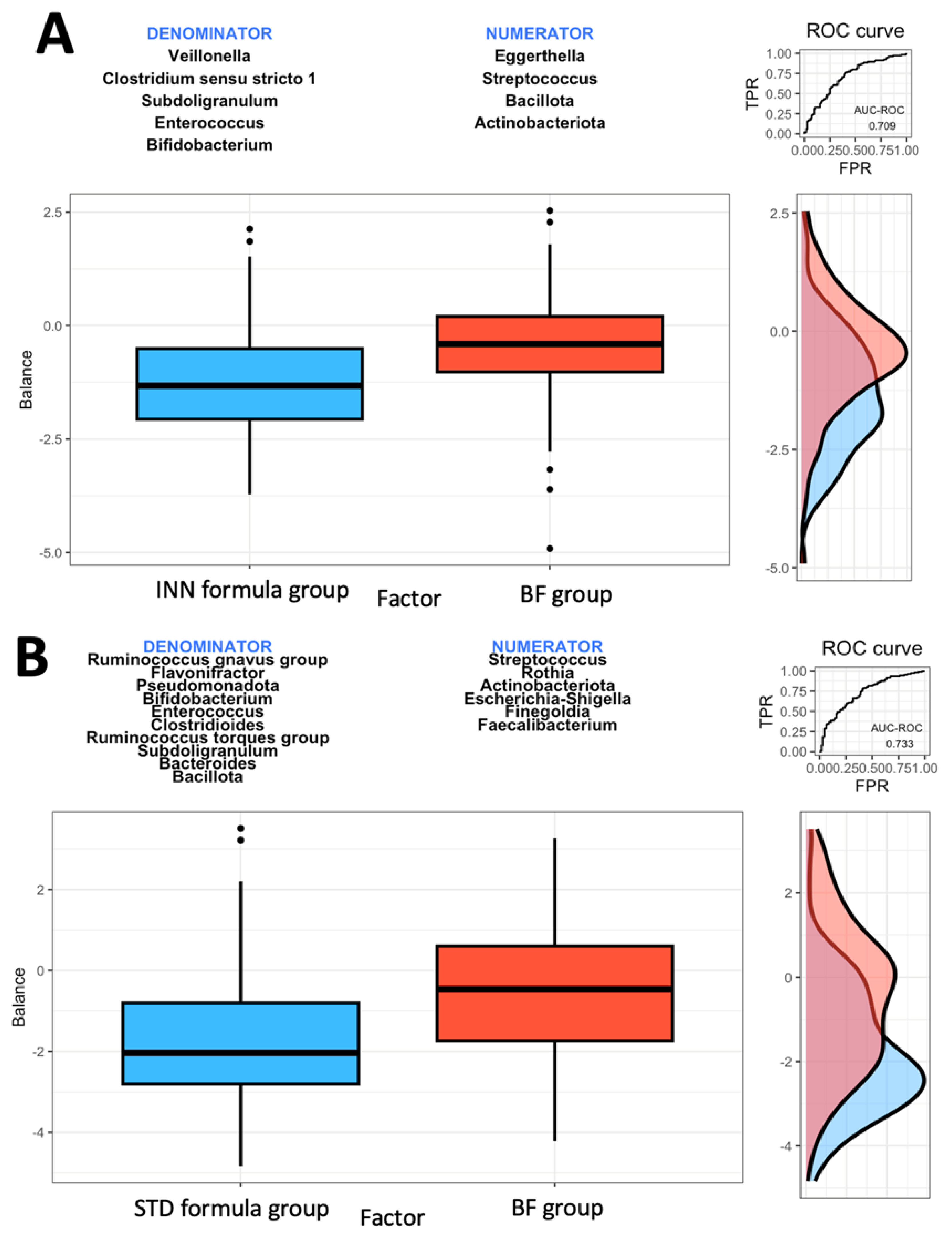
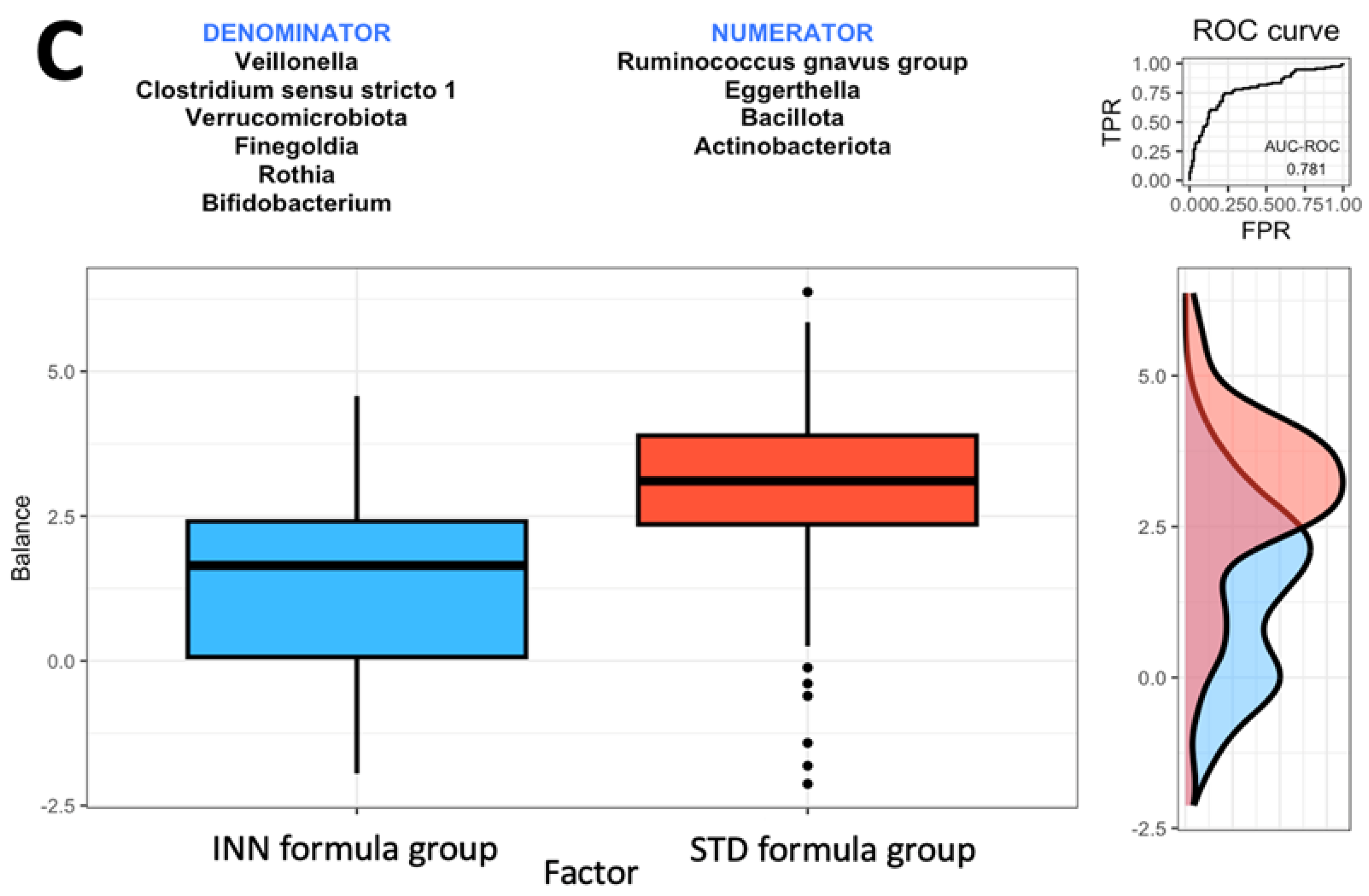
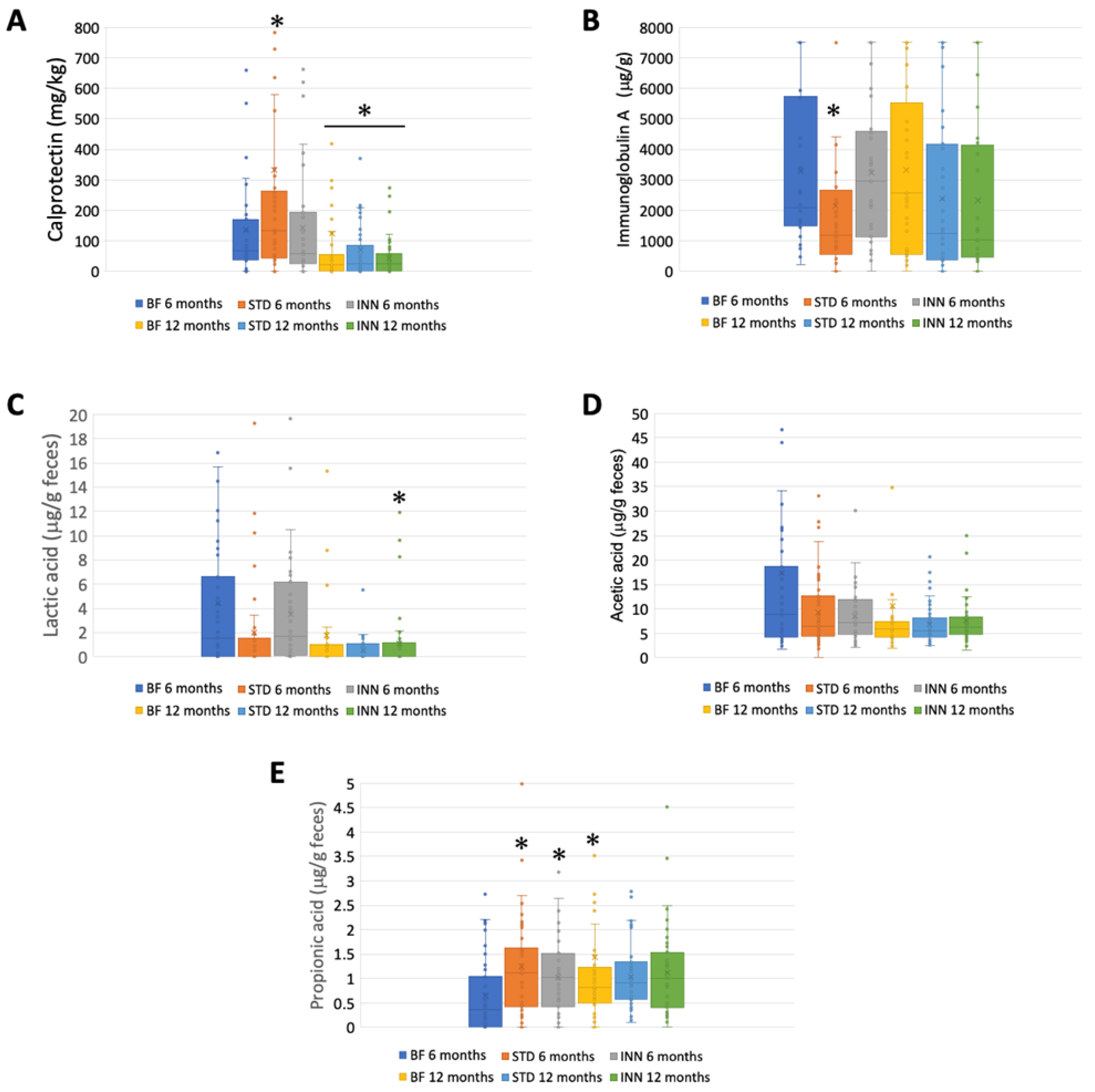
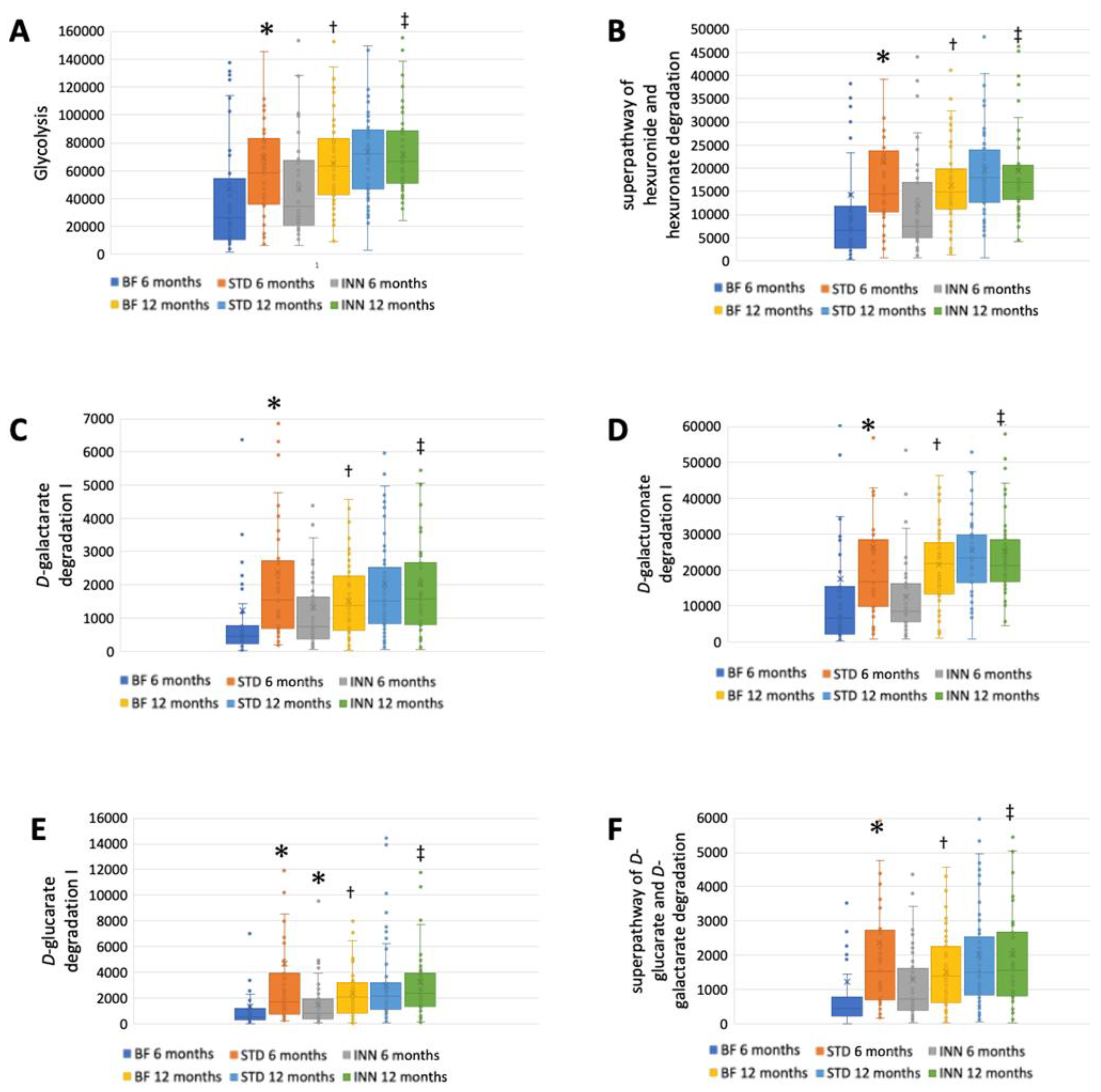
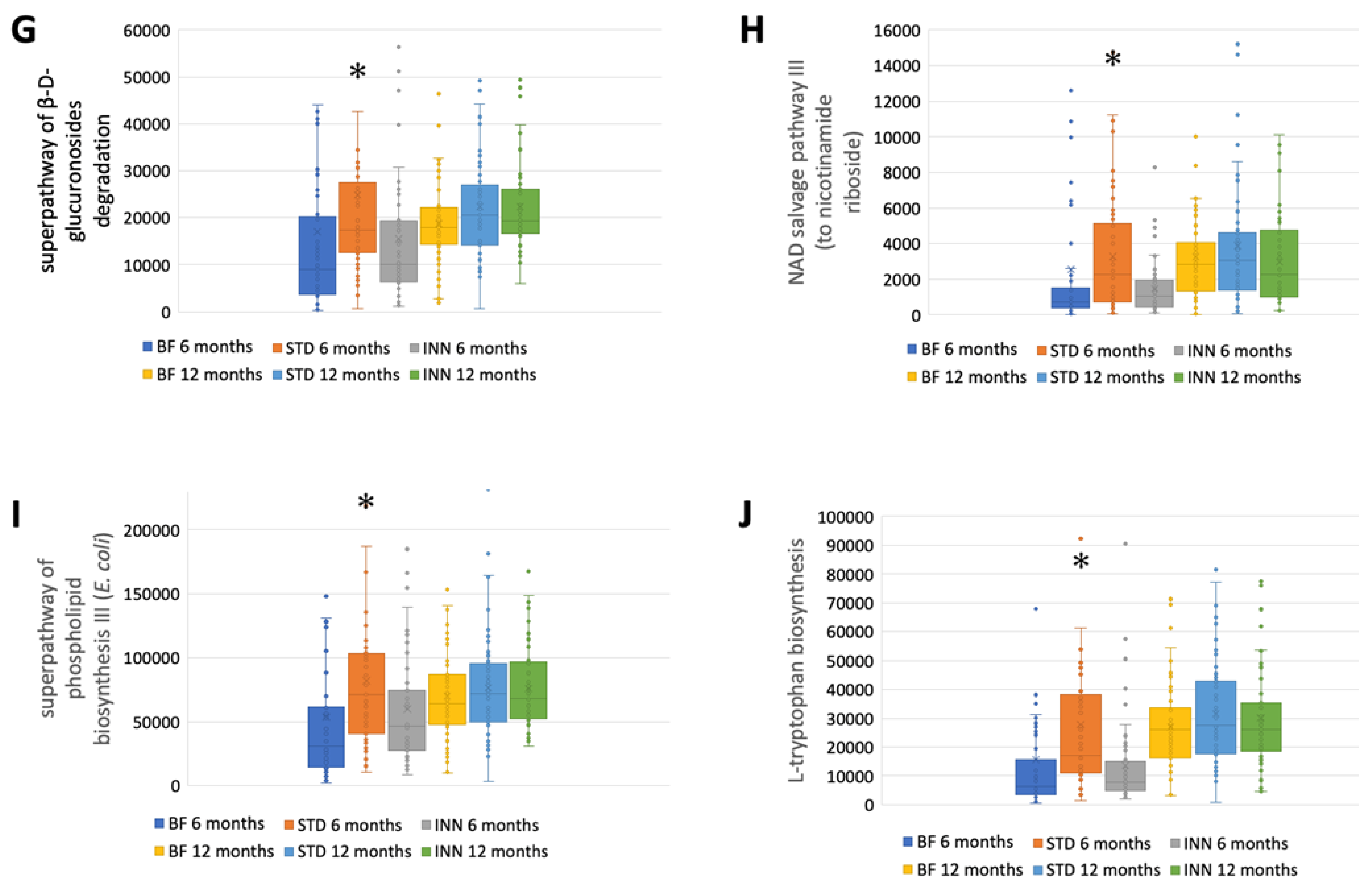
| Phylum | 6 Months | 12 Months | p-Value | ||||||
|---|---|---|---|---|---|---|---|---|---|
| BF (n = 52) | STD (n = 55) | INN (n = 52) | BF (n = 59) | STD (n = 63) | INN (n = 60) | BF | STD | INN | |
| Actinobacteriota | 88.4 (4.3–99.1) | 80.5 (1.5–98.6) | 92.5 (6.0–98.0) | 69.2 (8.5–97.6) | 65.2 (6.6–96.6) | 64.0 (1.9–95.9) | 0.155 | 0.065 | 0.155 |
| Bacillota | 10.2 (0.8–95.6) a | 15.8 (1.2–98.3) a | 6.9 (1.3–93.8) b | 28.5 (1.3–90.9) | 33.5 (2.2–93.1) | 34.6 (3.0–97.2) | 0.105 | 0.003 | <0.001 |
| Verrucomicrobiota | 0.05 (0–10.7) | 0.05 (0–66.6) | 0.04 (0–35.3) | 0.04 (0–15.2) ab | 0.03 (0–9.6) a | 0.07 (0–29.7) b | 0.509 | 0.078 | 0.509 |
| Pseudomonadota | 0.2 (0–1.1) | 0.2 (0.003–0.8) | 0.3 (0.01–1.2) | 0.1 (0–1.0) | 0.1 (0–1.0) | 0.1 (0–1.3) | 0.018 | 0.044 | 0.018 |
| Bacteroidota | 0.02 (0–1.0) | 0.1 (0–0.7) | 0.08 (0–0.8) | 0.04 (0–7.2) | 0.2 (0–0.8) | 0.2 (0–0.9) | 0.027 | 0.094 | 0.027 |
| Fusobacteriota | 0.0008 (0–4.2) | 0 (0–1.2) | 0.004 (0–0.4) | 0 (0–0.3) | 0 (0–0.3) | 0 (0–0.2) | 0.421 | 0.634 | 0.421 |
| Candidatus Patescibacteria | 0 (0–3.2) | 0 (0–0.01) | 0 (0–0) | 0 (0–0.2) | 0 (0–0.1) | 0.01 (0–0.2) | 0.411 | 0.364 | 0.411 |
| Synergistetes | 0 (0–0.05) | 0 (0–0.3) | 0 (0–0.2) | 0 (0–0.04) | 0 (0–0) | 0 (0–0) | 0.912 | 1 | 0.912 |
| Cyanobacteriota | 0 (0–0.1) | 0 (0–0.4) | 0 (0–0.09) | 0 (0–0.03) | 0 (0–0.2) | 0 (0–0.2) | 0.523 | 0.334 | 0.523 |
| Diversity | |||||||||
| Fisher index | 4.9 (2.9–8.3) a | 5.4 (2.7–11.9) b | 4.8 (2.81–8.6) a | 6.5 (3.0–12.9) | 6.8 (4.3–13.5) | 6.2 (2.9–15.0) | <0.001 | <0.001 | <0.001 |
| Shannon | 0.9 (0.09–2.0) a | 1.2 (0.1–2.1) b | 0.8 (0.3–1.5) a | 1.65 (0.3–3.0) | 1.85 (1.0–3.0) | 1.7 (0.7–2.6) | <0.001 | <0.001 | <0.001 |
| Inverse Simpson | 1.9 (1.0–6.6) ab | 2.4 (1.0–5.4) a | 1.6 (1.1–2.8) b | 2.72 (1.1–12.8) | 3.36 (1.6–11.5) | 3.1 (1.3–7.8) | <0.001 | <0.001 | <0.001 |
| Pielou’s evenness | 0.25 (0.03–0.6) a | 0.32 (0.04–0.6) b | 0.22 (0.08–0.4) a | 0.43 (0.09–0.7) | 0.48 (0.3–0.7) | 0.44 (0.2–0.6) | <0.001 | <0.001 | <0.001 |
| Species richness | 37.2 (24–59) a | 40.7 (22–80) b | 36.4 (23–61) a | 48 (25–86) | 49.5 (33–89) | 46 (24–98) | <0.001 | <0.001 | <0.001 |
| Simpson | 0.37 (0.02–0.9) ab | 0.48 (0.03–0.8) a | 0.32 (0.08–0.6) b | 0.63 (0.09–0.9) | 0.7 (0.4–0.9) | 0.68 (0.2–0.9) | <0.001 | <0.001 | <0.001 |
| Genus | 6 Months | 12 Months | p-Values | ||||||
|---|---|---|---|---|---|---|---|---|---|
| BF (n = 52) | STD (n = 55) | INN (n = 52) | BF (n = 59) | STD (n = 63) | INN (n = 60) | BF | STD | INN | |
| Bifidobacterium | 78.7 (3.6–98.9) a | 68.5 (0.8–98.3) b | 82.7 (4.8–95.7) a | 53.8 (4.0–95.2) | 48.0 (5.4–77.2) | 51.2 (15.5–89.0) | <0.001 | 0.006 | <0.001 |
| Clostridium sensu stricto 1 | 0.5 (0–72.4) a | 0.5 (0–88.5) a | 1.4 (0.01–16.9) b | 0.6 (0.01–26.0) | 0.8 (0–27.7) | 1.2 (0.02–34.3) | 0.653 | 0.156 | 0.850 |
| Collinsella | 0.4 (0.03–50.9) | 0.3 (0.01–54.9) | 0.6 (0–63.7) | 2.6 (0.02–44.7) | 1.9 (0.02–34.1) | 5.9 (0.04–33.4) | 0.009 | 0.156 | 0.014 |
| Blautia | 0.06 (0–12.3) | 0.1 (0–41.4) | 0.05 (0–13.3) | 0.4 (0–7.7) | 0.8 (0–24.5) | 0.5 (0–9.5) | <0.001 | 0.001 | <0.001 |
| Ruminococcus gnavus group | 0.2 (0.01–41.0) a | 1.6 (0–46.7) b | 0.2 (0–73.9) a | 0.5 (0.02–15.9) | 0.8 (0.06–18.4) | 0.8 (0.04–14.0) | 0.113 | 0.400 | 0.037 |
| Clostridioides | 0.04 (0–5.8) a | 0.3 (0–24.3) b | 0.03 (0–39.7) a | 0.02 (0–2.1) | 0.02 (0–0.5) | 0.04 (0–1.6) | 0.772 | 0.001 | 0.850 |
| Akkermansia | 0.06 (0–10.9) | 0.05 (0–66.1) | 0.04 (0–35.6) | 0.04 (0–14.6) | 0.05 (0–23.3) | 0.06 (0–30.5) | 0.460 | 0.967 | 0.343 |
| Eggerthella | 0.2 (0–5.2) | 0.5 (0–15.5) | 0.09 (0–5.7) | 0.3 (0–7.2) | 0.3 (0–3.2) | 0.2 (0–2.5) | 0.692 | 0.642 | 0.126 |
| Flavonifractor | 0.04 (0–13.4) a | 0.2 (0–9.6) b | 0.03 (0–3.2) a | 0.1 (0–1.8) | 0.2 (0–1.2) | 0.1 (0–2.2) | 0.194 | 0.911 | 0.001 |
| Subdoligranulum | 0.02 (0–19.5) | 0.02 (0–13.6) | 0 (0–0.2) | 0.05 (0–7.3) | 0.07 (0–24.7) | 0.1 (0–24.8) | 0.048 | 0.010 | <0.001 |
| Rothia | 0.04 (0–1.2) a | 0.02 (0–0.3) a | 0.06 (0–0.6) b | 0.03 (0–0.5) | 0.005 (0–1.6) | 0.02 (0–0.5) | 0.607 | 0.175 | 0.009 |
| Faecalibacterium | 0.04 (0–5.5) | 0.07 (0–27.1) | 0.05 (0–3.6) | 5.0 (0–18.7) | 3.2 (0–22.0) | 1.5 (0.02–36.5) | <0.001 | <0.001 | <0.001 |
| Lachnoclostridium | 0 (0–17.3) a | 0.06 (0–4.1) b | 0 (0–3.5) a | 0.1 (0–12.8) | 0.3 (0–6.0) | 0.2 (0–2.6) | <0.001 | <0.001 | <0.001 |
| UBA1819 | 0 (0–12.5) | 0 (0–16.6) | 0 (0–2.5) | 0.02 (0–1.4) | 0.4 (0–3.2) | 0.02 (0–3.4) | 0.101 | 0.134 | 0.126 |
| Anaerostipes | 0.06 (0–6.2) | 0.08 (0–6.6) | 0.03 (0–3.0) | 1.0 (0–17.7) | 1.4 (0.04–9.8) | 0.6 (0–9.5) | <0.001 | <0.001 | <0.001 |
| Escherichia-Shigella | 0.2 (0–0.9) a | 0.1 (0–0.7) a | 0.3 (0–1.0) b | 0.02 (0–0.5) | 0 (0–0.3) | 0.02 (0–0.4) | <0.001 | <0.001 | <0.001 |
| Streptococcus | 0.09 (0–1.4) a | 0.01 (0–0.9) b | 0.05 (0–0.7) a | 0.05 (0–0.6) | 0.04 (0–0.8) | 0.05 (0–0.5) | 0.113 | 0.037 | 0.850 |
| Ruminococcus | 0 (0–0.2) | 0 (0–0.7) | 0 (0–0.2) | 0.02 (0–10.3) | 0.01 (0–6.9) | 0.04 (0–5.5) | 0.047 | <0.001 | 0.001 |
| Eubacterium hallii group | 0 (0–9.7) | 0.01 (0–6.0) | 0.01 (0–1.2) | 0.2 (0–11.7) | 0.06 (0–19.1) | 0.08 (0–6.5) | 0.008 | <0.001 | 0.001 |
| Ruminococcus torques group | 0.01 (0–1.1) | 0.03 (0–19.7) | 0.01 (0–9.9) | 0.2 (0–19.9) | 0.3 (0–9.8) | 0.1 (0–8.9) | <0.001 | <0.001 | <0.001 |
| Veillonella | 0.1 (0–0.7) | 0.1 (0–0.8) | 0.2 (0–0.8) | 0.02 (0–0.7) a | 0.01 (0–0.7) a | 0.09 (0–0.5) b | 0.018 | <0.001 | 0.014 |
| Roseburia | 0 (0–0.07) | 0 (0–0.09) | 0 (0–0.08) | 0(0–2.0) | 0.01 (0–2.4) | 0.005 (0–1.4) | <0.001 | <0.001 | <0.001 |
| Bacteroides | 0.01 (0–0.9) | 0.07 (0–0.6) | 0.1 (0–0.9) | 0.2 (0–0.6) | 0.2 (0–0.6) | 0.2 (0–0.5) | 0.018 | 0.072 | 0.570 |
| Enterococcus | 0.01 (0–0.4) | 0.03 (0–1.0) | 0.06 (0–0.8) | 0(0–0.5) | 0 (0–0.4) | 0 (0–0.4) | 0.045 | <0.001 | <0.001 |
| Eubacterium | 0 (0–5.9) | 0 (0–2.5) | 0 (0–1.6) | 0(0–0.2) | 0 (0–1.0) | 0 (0–1.2) | 0.387 | 0.115 | 1 |
Disclaimer/Publisher’s Note: The statements, opinions and data contained in all publications are solely those of the individual author(s) and contributor(s) and not of MDPI and/or the editor(s). MDPI and/or the editor(s) disclaim responsibility for any injury to people or property resulting from any ideas, methods, instructions or products referred to in the content. |
© 2023 by the authors. Licensee MDPI, Basel, Switzerland. This article is an open access article distributed under the terms and conditions of the Creative Commons Attribution (CC BY) license (https://creativecommons.org/licenses/by/4.0/).
Share and Cite
Plaza-Diaz, J.; Ruiz-Ojeda, F.J.; Morales, J.; Martín-Masot, R.; Climent, E.; Silva, Á.; Martinez-Blanch, J.F.; Enrique, M.; Tortajada, M.; Ramon, D.; et al. Innova 2020: A Follow-Up Study of the Fecal Microbiota of Infants Using a Novel Infant Formula between 6 Months and 12 Months of Age. Int. J. Mol. Sci. 2023, 24, 7392. https://doi.org/10.3390/ijms24087392
Plaza-Diaz J, Ruiz-Ojeda FJ, Morales J, Martín-Masot R, Climent E, Silva Á, Martinez-Blanch JF, Enrique M, Tortajada M, Ramon D, et al. Innova 2020: A Follow-Up Study of the Fecal Microbiota of Infants Using a Novel Infant Formula between 6 Months and 12 Months of Age. International Journal of Molecular Sciences. 2023; 24(8):7392. https://doi.org/10.3390/ijms24087392
Chicago/Turabian StylePlaza-Diaz, Julio, Francisco Javier Ruiz-Ojeda, Javier Morales, Rafael Martín-Masot, Eric Climent, Ángela Silva, Juan F. Martinez-Blanch, María Enrique, Marta Tortajada, Daniel Ramon, and et al. 2023. "Innova 2020: A Follow-Up Study of the Fecal Microbiota of Infants Using a Novel Infant Formula between 6 Months and 12 Months of Age" International Journal of Molecular Sciences 24, no. 8: 7392. https://doi.org/10.3390/ijms24087392
APA StylePlaza-Diaz, J., Ruiz-Ojeda, F. J., Morales, J., Martín-Masot, R., Climent, E., Silva, Á., Martinez-Blanch, J. F., Enrique, M., Tortajada, M., Ramon, D., Alvarez, B., Chenoll, E., & Gil, Á. (2023). Innova 2020: A Follow-Up Study of the Fecal Microbiota of Infants Using a Novel Infant Formula between 6 Months and 12 Months of Age. International Journal of Molecular Sciences, 24(8), 7392. https://doi.org/10.3390/ijms24087392









